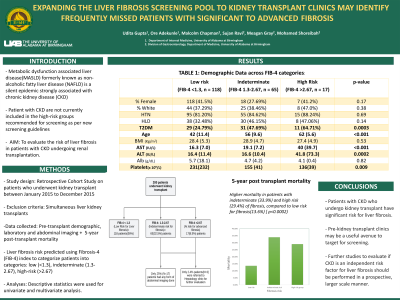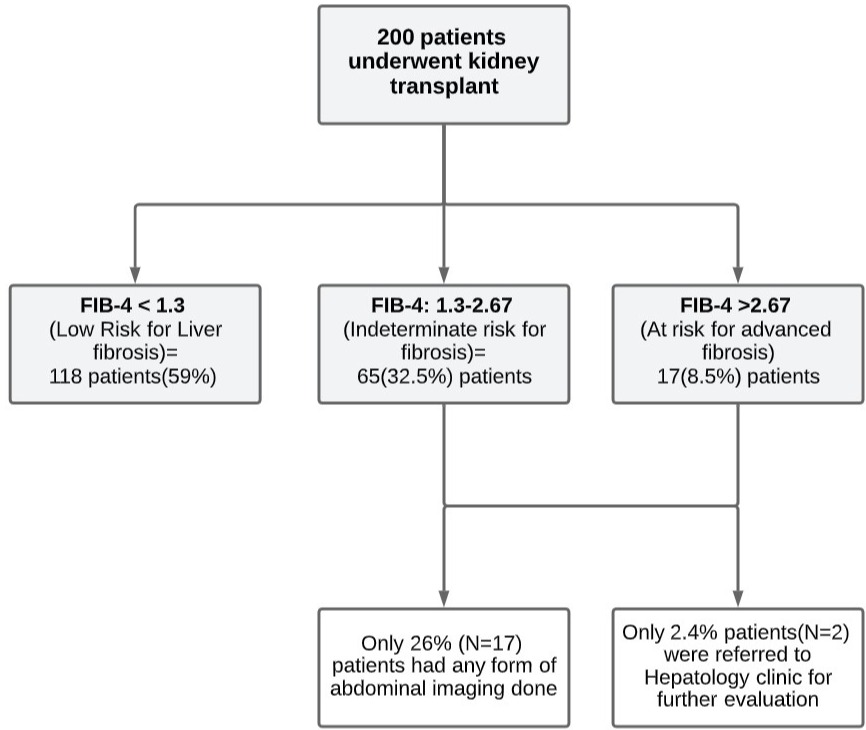Tuesday Poster Session
Category: Liver
P3822 - Expanding the Liver Fibrosis Screening Pool to Kidney Transplant Clinics May Identify Frequently Missed Patients With Significant to Advanced Fibrosis
Tuesday, October 24, 2023
10:30 AM - 4:00 PM PT
Location: Exhibit Hall

Has Audio
.jpg)
Udita Gupta, MD
University of Alabama at Birmingham
Birmingham, AL
Presenting Author(s)
Udita Gupta, MD1, Oreoluwa Adekunle, MD1, Malcolm Chapman, MD1, Dalton A. Norwood, MD2, Meagan Gray, MD1, Mohamed Shoreibah, MD1, Sujan Ravi, MD1
1University of Alabama at Birmingham, Birmingham, AL; 2UAB Minority Health and Health Equity Research Center, The University of Alabama at Birmingham Heersink School of Medicine, Birmingham, AL
Introduction: Non-alcoholic fatty liver disease (NAFLD) is a silent epidemic strongly associated with chronic kidney disease (CKD). Recently, screening guidelines have been created to guide physicians in screening patients with NAFLD risk factors for significant liver fibrosis, however, patients with CKD are not currently included in the high-risk groups recommended for screening. Therefore, we aimed to evaluate the risk of liver fibrosis in patients with CKD undergoing renal transplantation.
Methods: We performed a retrospective cohort study of patients who underwent kidney transplantation at our institution between January 2015 and December 2015. We excluded patients who had undergone simultaneous liver-kidney transplant. Pre-transplant demographic, laboratory, and abdominal imaging data were collected in addition to 5-year post-transplant mortality. Liver fibrosis risk pre-transplant was predicted using the Fibrosis-4 (FIB-4) index to categorize patients into low (< 1.3), indeterminate (1.3-2.67), and high-risk ( >2.67) categories. Descriptive statistics were used for univariate and multivariate analysis.
Results: 200 patients met the inclusion criteria. Demographic data across FIB-4 categories is shown in Table 1. Those at high risk of advanced fibrosis were older, had a higher prevalence of type 2 diabetes (T2DM), higher aspartate aminotransferase and alanine aminotransferase values, and lower platelet counts. Of those at indeterminate to high risk, 26% patients had abdominal imagining and 2.4% patients had hepatology evaluation. 5-year mortality after renal transplant was significantly different between those in the indeterminate (33.9%) and high-risk (29.4%) categories compared to those at low risk for advanced fibrosis (13.6%) (p = 0.0002).
Discussion: Patients with CKD who undergo kidney transplant have a significant risk for liver fibrosis. Given the thorough current pre-transplant assessment protocols, pre-kidney transplant clinics may be a useful avenue to target for screening. Further studies to evaluate if CKD is an independent risk factor for liver fibrosis should be performed in a prospective, larger-scale manner.

Disclosures:
Udita Gupta, MD1, Oreoluwa Adekunle, MD1, Malcolm Chapman, MD1, Dalton A. Norwood, MD2, Meagan Gray, MD1, Mohamed Shoreibah, MD1, Sujan Ravi, MD1. P3822 - Expanding the Liver Fibrosis Screening Pool to Kidney Transplant Clinics May Identify Frequently Missed Patients With Significant to Advanced Fibrosis, ACG 2023 Annual Scientific Meeting Abstracts. Vancouver, BC, Canada: American College of Gastroenterology.
1University of Alabama at Birmingham, Birmingham, AL; 2UAB Minority Health and Health Equity Research Center, The University of Alabama at Birmingham Heersink School of Medicine, Birmingham, AL
Introduction: Non-alcoholic fatty liver disease (NAFLD) is a silent epidemic strongly associated with chronic kidney disease (CKD). Recently, screening guidelines have been created to guide physicians in screening patients with NAFLD risk factors for significant liver fibrosis, however, patients with CKD are not currently included in the high-risk groups recommended for screening. Therefore, we aimed to evaluate the risk of liver fibrosis in patients with CKD undergoing renal transplantation.
Methods: We performed a retrospective cohort study of patients who underwent kidney transplantation at our institution between January 2015 and December 2015. We excluded patients who had undergone simultaneous liver-kidney transplant. Pre-transplant demographic, laboratory, and abdominal imaging data were collected in addition to 5-year post-transplant mortality. Liver fibrosis risk pre-transplant was predicted using the Fibrosis-4 (FIB-4) index to categorize patients into low (< 1.3), indeterminate (1.3-2.67), and high-risk ( >2.67) categories. Descriptive statistics were used for univariate and multivariate analysis.
Results: 200 patients met the inclusion criteria. Demographic data across FIB-4 categories is shown in Table 1. Those at high risk of advanced fibrosis were older, had a higher prevalence of type 2 diabetes (T2DM), higher aspartate aminotransferase and alanine aminotransferase values, and lower platelet counts. Of those at indeterminate to high risk, 26% patients had abdominal imagining and 2.4% patients had hepatology evaluation. 5-year mortality after renal transplant was significantly different between those in the indeterminate (33.9%) and high-risk (29.4%) categories compared to those at low risk for advanced fibrosis (13.6%) (p = 0.0002).
Discussion: Patients with CKD who undergo kidney transplant have a significant risk for liver fibrosis. Given the thorough current pre-transplant assessment protocols, pre-kidney transplant clinics may be a useful avenue to target for screening. Further studies to evaluate if CKD is an independent risk factor for liver fibrosis should be performed in a prospective, larger-scale manner.

Figure: Evaluation for Liver Fibrosis in Kidney Transplant Clinic
Disclosures:
Udita Gupta indicated no relevant financial relationships.
Oreoluwa Adekunle indicated no relevant financial relationships.
Malcolm Chapman: CVS Health – Employee.
Dalton Norwood indicated no relevant financial relationships.
Meagan Gray indicated no relevant financial relationships.
Mohamed Shoreibah indicated no relevant financial relationships.
Sujan Ravi indicated no relevant financial relationships.
Udita Gupta, MD1, Oreoluwa Adekunle, MD1, Malcolm Chapman, MD1, Dalton A. Norwood, MD2, Meagan Gray, MD1, Mohamed Shoreibah, MD1, Sujan Ravi, MD1. P3822 - Expanding the Liver Fibrosis Screening Pool to Kidney Transplant Clinics May Identify Frequently Missed Patients With Significant to Advanced Fibrosis, ACG 2023 Annual Scientific Meeting Abstracts. Vancouver, BC, Canada: American College of Gastroenterology.
